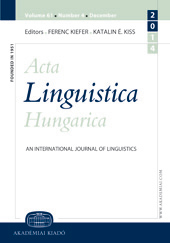The presence of head-raising and resumptive-stranding in Japanese relative clauses
The presence of head-raising and resumptive-stranding in Japanese relative clauses
Author(s): Yasuyuki KitaoSubject(s): Theoretical Linguistics
Published by: Akadémiai Kiadó
Keywords: relative clauses; weak crossover; reconstruction/connectivity; island insensitivity; head-raising; resumptive pronouns; Japanese;
Summary/Abstract: Japanese relative clauses (RCs) show peculiar characteristics. For instance, while weak crossover effects reveal that relativization includes movement, the absence of island effects seems to demonstrate that relativization does not include movement. Ishii (1991) accounts for this peculiarity of Japanese RCs by his last-resort analysis; however, because of the Inclusiveness Condition (Chomsky 1995), this last-resort model is not tenable in the Minimalist Program (MP). Therefore, an improved characterization of Ishii’s last-resort analysis of relativization in Japanese is needed within the framework of the MP. In this paper, I claim that reconstruction/connectivity effects show that Japanese RCs include promotion/head-raising. I then propose that the amendment of Boeckx’s (2003) resumptive-stranding model, which includes promotion/head-raising of a relative head and pro-stranding, can offer an account of both the movement properties and non-movement properties of Japanese RCs. The proposed analysis conforms to Inclusiveness. Also, I claim that the unavailability of A-scrambling in Japanese RCs, which could be raised as an objection to the promotion/head-raising analysis, is due to the ban on Improper Movement (Müller — Sternefeld 1993; 1996).
Journal: Acta Linguistica Hungarica (Since 2017 Acta Linguistica Academica)
- Issue Year: 58/2011
- Issue No: 3
- Page Range: 313-335
- Page Count: 23
- Language: English

